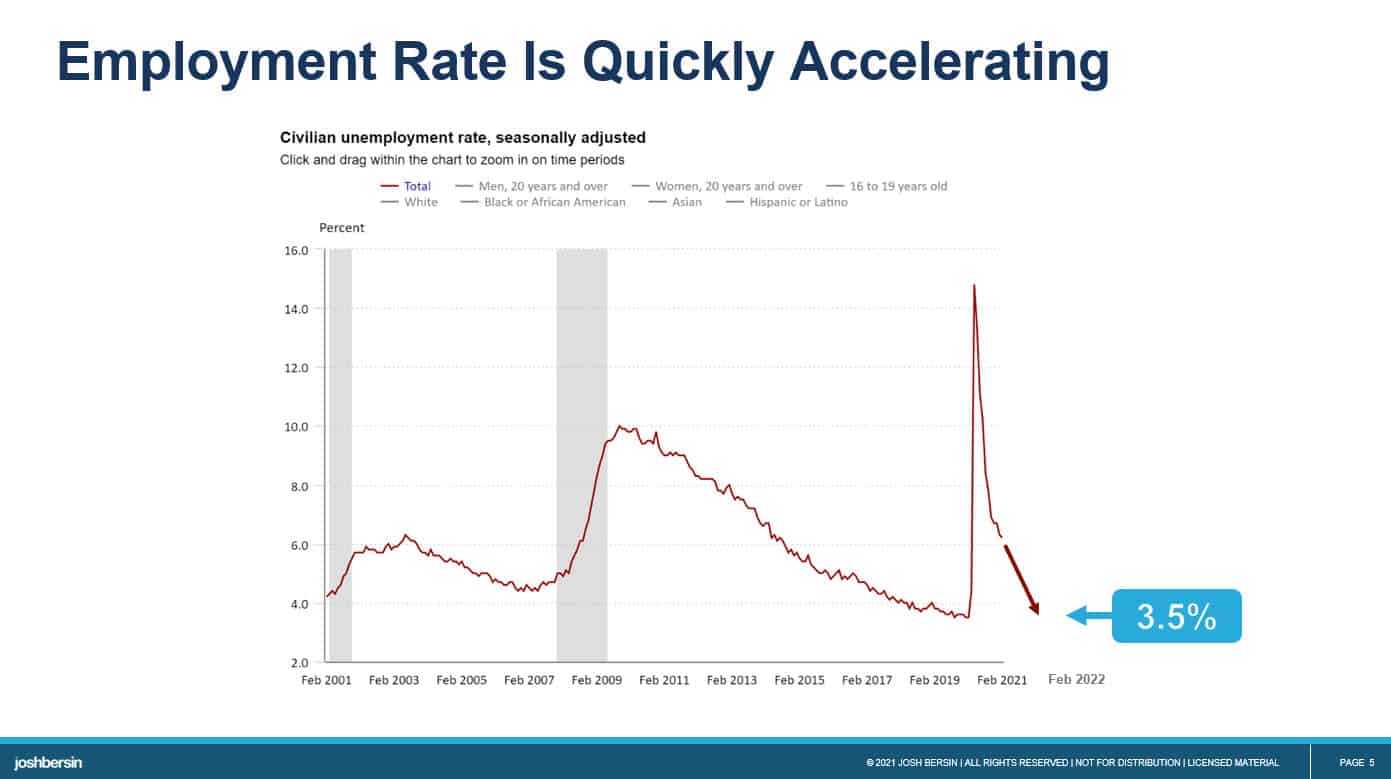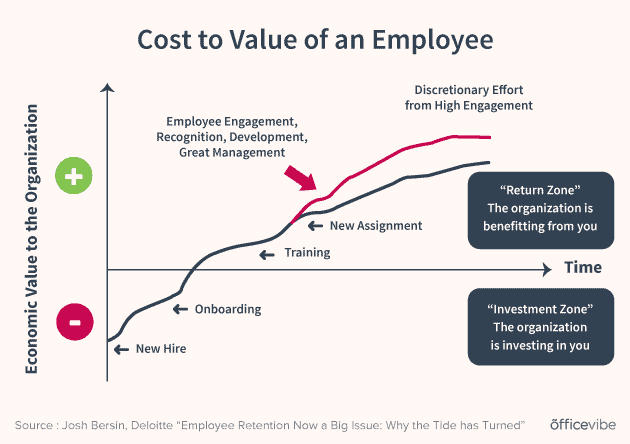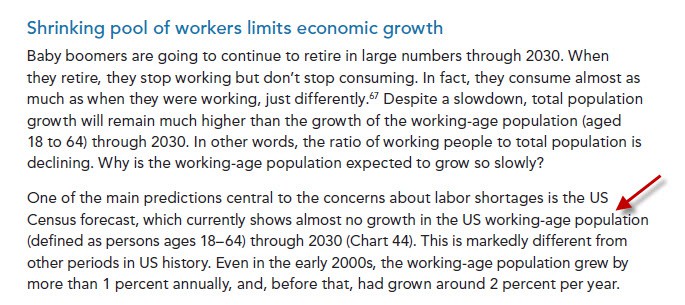What To Expect In A Red Hot Job Market? Five Things To Consider.
There’s no question in my mind, we are entering one of the hottest job markets in a decade.
Not only will the $1.9 Trillion American Rescue Plan boost the economy, we are already operating with 13% more open jobs than we had a year ago. And my own estimates (and Goldman Sachs) expect the unemployment rate to be around 4.1% by year-end.
 |
And to make matters worse, the birth rate has dropped precipitously, telling us that the workforce will be even more constrained in the decade ahead. And the shortage of “blue-collar” workers is an even bigger issue, as a report from The Conference Board points out.
This is not the first time we’ve seen this, but let me remind you what to expect.
What To Expect
1/ Wages will rise, you will need to adapt.
Every study of employment and hiring shows that wages go up during a labor shortage. I don’t need to remind you how hard it was to hire software engineers during the last economic cycle (one of our clients told me they were adjusting wages quarterly to keep their engineers happy). Well, we’re about to see the same thing again.
I am not fully confident that the BLS wage data is accurate (it always seems to understate inflation) but I’m very sure that most of you are going to need to look at your compensation strategies again. The Conference Board survey found that the #1 thing companies do when they can’t find people is raise wages (82% do this), followed closely by “increase social media marketing.”
Right now more than 32% of wages in the US go to “non-payroll spending” (insurance, healthcare, vacation), and that percentage keeps ticking up as companies increase wellbeing programs. And several studies have pointed out that more than half of employees expect raises this year because there is inflation in many parts of the economy.
2/ Increase investment in employment brand, sourcing, and job advertising.
The second thing to consider is how well you’ve funded and managed your talent acquisition team. Job advertising, employment branding, sourcing, and search will get hot. These areas of HR have never really gone away, but most of us focused more on gig work hiring last year. Coming into the second half of this year you’ll be doing some serious searching for sales, service, production, logistics, and professional roles.
The average company spends around $2700 on each new hire, but of course, this number goes way up for professional and senior roles. This enormous spending is often spent chaotically (it’s like advertising), so it’s a good year to spend time upgrading your Talent Acquisition tools and analyzing where this money is going. Remember that even in a good economic year, approximately 40 million Americans change jobs.
3/ Accelerate your Internal Talent Marketplace.
The third thing that happens during a labor shortage is “time to hire” goes up. It starts to take months to find people, and employees start hopping around. This makes an even bigger case for internal mobility.
As I’ve written about many times, one of the most exciting innovations in HR is the internal talent marketplace. Big companies like Cisco and IBM have had strong internal mobility programs for years – now you can do it in a precision and targeted way.
For example, if you have a good talent mobility system you can find all the designers, marketing professionals, software engineers, or analysts and move them from business unit to business unit based on demand. This is a good thing for their careers and greatly increases the dynamism of your company. The same is true for leadership roles, sales roles, and HR professionals.
There are many cultural issues that come up with internal mobility (we have identified about 40 of them), but now is the time to figure this out. I have studied this process many times and I can guarantee that internal mobility will be less expensive than 100% external hiring and it has many other business benefits. Call us if you’d like some help.
4/ Invest in the Engagement and People Analytics Team.
During a competitive labor market, people feel less “attached” to their employer, so they start looking around. And as most studies have shown, employee retention is like “death by a thousand cuts.” People start to feel a little unhappy, something happens at work that doesn’t feel right, and soon enough they’re scanning jobs on LinkedIn.
You can prevent this with a strong focus on employee engagement, belonging, and feedback. As I’ve written about many times, the most important employee engagement program you have is “listening,” and this means teaching managers, leaders, and HR how to pay attention. Many companies start to pay and measure managers by the engagement and retention of their teams, for example. And it’s time to start looking at data about who is leaving and why. (Our People Analytics program in the Josh Bersin Academy is our most popular program, by the way.)
Most companies are pretty good at this right now, but we haven’t used these muscles for a while. Revisit our Simply Irresistible model if you need some ideas. But you have to pay attention now, once the job market heats up people will move around quickly.
(PS. You can also expect lots of vacation and leave once the “pandemic” officially ends.)
5/ Double down on the Employee Experience program.
Finally, among many other things, continue to invest in your EX program. Employee Experience means creating a strong onboarding program, making sure work is productive and easy, focusing on setting clear goals and targets, and giving employees development, career growth, and on-the-job learning. (And watch for our new study of EX – we’ve uncovered some other important secrets, most of which fall on the shoulders of management, not HR.)
By the way, several studies (Qualtrics, Glint, and most recently WeSpire) found that employees who feel directly aligned with their company’s Purpose are 3X less likely to look for a new job when it comes along. So you may want to spend some time revisiting your company’s Purpose and Mission and reminding people what it is. This is a “free” way to improve retention.
Only a few years ago retention was a hot topic, but HR teams have been so busy with remote work and safe workplace programs they may have lost focus. It’s time to spend some time with leaders and coach them on goal management, focus, coaching, and productivity. And as the economy heats up, I also suggest you brush off your skills in organization design – just “piling on more people” doesn’t help the company scale.
The Cost of losing people is high.
If you haven’t thought about retention for a while, let me point something else out. The cost of losing people is high, and it gets much higher in a tight labor market. Most studies show that it can cost 2-3X first year salary to replace someone (the cost of advertising, recruiting, onboarding, training, and lost productivity) so now is the time to make sure people are happy.
The more time you spend on the right side of this chart the better.
 |
The Economy Matters: The Labor Market Is Not Growing
Let me add that employment growth is going to have a lot of economic effects as well. Studies show that while labor productivity is rising, our GDP will not be able to rise without more workers. The Conference Board study points out that the low birth rate, coupled with four years of reduced immigration, is going to hold back economic growth in the US.
Japan, Germany, and now China are experiencing this effect: as the population ages, there are just fewer people to work. (The Conference Board economists point out the non-college-educated working-age population is shrinking.)
 |
The Biden Administration understands this, so I believe we will see much more flexibility for immigration, work permits, and family incentives (a big part of The Rescue Act) to encourage people to have children and come into this country. And of course, more money will be spent on reskilling and job training. (Note also that the Biden Administration is also strongly pro-union, which will also increase wages.)
It’s going to be an exciting year as the economy continues to heat up. Let’s work together and we can make work and jobs as enjoyable as ever as we look forward to the “post-pandemic” economy.
